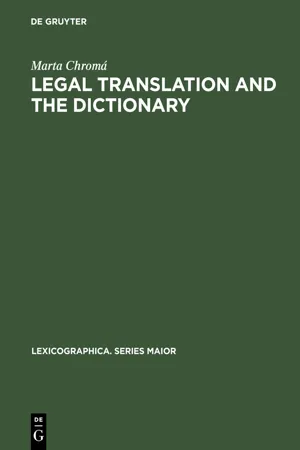
- 128 pages
- English
- PDF
- Available on iOS & Android
Legal Translation and the Dictionary
About This Book
This study concentrates on three major issues creating a basis for the making of the "Czech-English Law Dictionary with Explanations", namely language, including terminology, in both the Czech and Anglo-American systems of law; the process of legal translation; and the lexicographic method of producing a bilingual law dictionary. Terminology has been considered the most significant feature of language for legal purposes. It encompasses a wide range of special-purpose vocabulary and higher syntactic units, including legal jargon. Conceptual analysis is to be pursued whenever an identical term in the target language does not exist or its full equivalent is in doubt. Legal translation should be based primarily on comparative legal, linguistic and genre analysis in order to make the transfer of legal information as precise, accurate and comprehensible as possible. The primary objective of legal translation is for the target recipient to be provided as explicit, extensive and precise legal information in the target language as is contained in the source text, complemented (by the translator) with facts rendering the original information fully comprehensible in the different legal environment and culture. A dictionary which will help its users to produce legal texts in the target language should be founded upon a profound comparative legal and linguistic analysis that will (a) determine equivalents at the levels of vocabulary, syntax and genre, (b) select the appropriate lexicographic material to be included in the dictionary, and (c) create entries in a user-friendly manner.
Frequently asked questions
Information
Table of contents
- Foreword
- I. Introduction
- II. Law dictionary and the language of the law
- 1. Objectives of the Dictionary
- 1.1. Defining target users
- 2. Legal framework
- 2.1. Validity of Czech legislative texts
- 2.2. Differences between legal systems
- 2.3. Differences among English-speaking countries
- 3. Linguistic framework
- 3.1. LSP, LLP and Terminology
- 3.2. Linguistics of Translation
- 4. Lexicographical framework
- 4.1. Theory of lexicography
- 4.2. Conceptual dictionary
- 4.3. Types of explanations
- 4.4. Collection of material and entry-processing
- 4.5. Software and Statistics
- III. Conclusion
- 1. Summary of findings
- 2. Implications for future research
- 2.1. Applied linguistics
- 2.2. Lexicography
- IV. Zusammenfassung
- V. Résumé
- VI. Bibliography